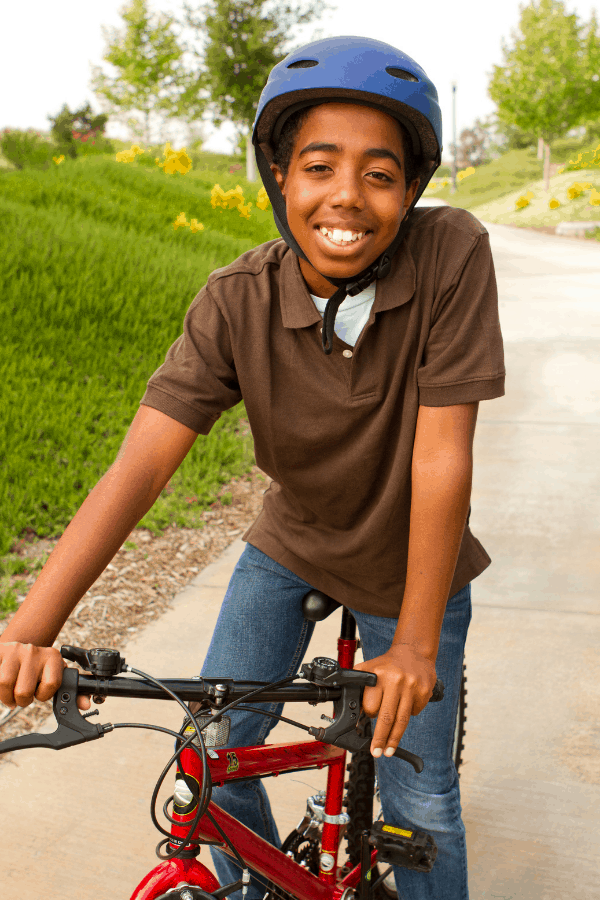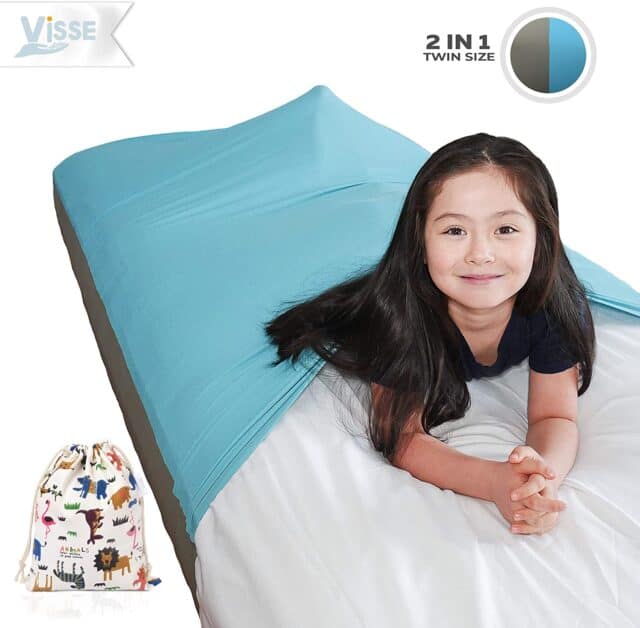Learn what to do when your child has a hard time falling asleep, won’t eat certain textures, what to do when your child is always on the go, and more help for parents who’s kids have sensory needs.
Last month, our Your Kid’s Table newsletter community had the chance to ask me anything, and boy did they! This post will be the first of three over the next month or so answering many of their burning questions about how they can help their children.
In this first installment, I’ll answer 5 questions all about sensory that will help a lot of parents navigate the sometimes confusing world of sensory.
You asked. I’m answering. Let’s get started!
Smart Sensory Questions from Parents
Question #1: Sensory Seeking Kid Needs Calming and Focus for School
I have a sensory seeking 5 year old who has just started kindergarten. Both of my kids are high energy until they drop. There seems to be no in between. Unfortunately, because of moving, quarantine, remodeling, etc., there has been too much screen time. I know this exacerbates their behavior, so we are trying to limit time. My son (5) definitely has some sensory seeking behavior. He seeks out hugs, often very tight, hits himself in the head when he’s feeling overly stimulated or when he’s frustrated, and he’s almost always running, jumping, moving, sometimes slamming into things, rolling around on the floor, etc. He has been in preschool, and he’s had some small successes with learning self control with his movement and behavior. But he’s been home for 6 months and is about to enter into a vastly different school environment than before. What are some sensory input things I can do with him to help calm him? – Lesleigh
I know a lot of you can relate to Lesleigh’s situation. If there are Covid restrictions in school, kids may have even less opportunities to move than before, so for our sensory seeking kids that LOVE movement, it will be important to give them the chance to get that movement before and after school.
While mornings can be hectic, there are some simple activities you can incorporate into their routine OR create some extra time in your schedule for a dedicated movement based sensory activity. Let me give you an example of both.
In your routine: Wake up and use a vibrating toothbrush because it gives lots of strong proprioceptive, vestibular, and tactile input. Then, hop or skip to the kitchen for breakfast. Eat a crunchy granola bar or drink a thick smoothie because they both give more sensory input too. Lastly, ride a bike or scooter to the bus stop.
With extra time: Give ten extra minutes in the morning to jump on their bed, the couch, or a trampoline. They could also run around outside, hop on the swingset, or use a scooterboard around the house.
Some kids don’t need the extra effort before school, so experiment and watch for how they respond….
-
- Did their school day seem to go more smoothly?
- Did you have any behavior reports from the teacher?
- What was their mood, activity level, and communication like when they got home from school?
Check in with your child and ask them if you aren’t sure.
Once your child is home after a long school day, they may be bouncing off the walls or completely overstimulated and need some quiet time. Watch for cues about what they might need, and again experiment. If they’re edgy and withdrawn, having a sensory tent or dedicated sensory space could give them the sensations they need to re-balance their system.
If your child is full of energy, they’ll likely need some movement to regulate their sensory needs. But, kids that are withdrawn may as well. You can give a child a choice of activities after school to help them regulate by saying, “Would you like to swing or use some of the fidget toys in your quiet spot?”
They might not be sure, in which case help them pick one and again, watch to see if it helped them. Sometimes, it does take some experimenting to find what works. But, in general, think about having a few sensory based activities in mind for when they get home.
Get inspired with over 100 different sensory diet activities that are great for before or after school.

Question #2:
How sensory processing can affect bedtime…? – Anonymous
This was one of many questions about sleep! Sleep is complex and many factors affect it including screen time, food sensitivities, anxiety, AND sensory processing.
From a sensory standpoint, if a child’s sensory system is out of balance, they may not be able to fall asleep. Many of our kids are walking around unbalanced or dysregulated throughout the day either because they need more of a particular sensation or less of one.
For example, if a child needs a lot of proprioceptive input, they may climb, run, and crash into things throughout the day. Sometimes, theses needs are so great that kids need A LOT of it. If they don’t get it, then they feel “off” and can’t fall asleep.
In the same way, if a child is super sensitive to smells, noises, and/or touch and are trying to go to bed after a big family dinner, they may be so overstimulated they can’t calm to go to sleep.
It’s hard for adults to relate to this, so imagine you just had to do something you hate, like listen to nails on a chalkboard for 5 minutes, clean out pumpkin guts for an hour with your hands in that goo, or be stuck on an elevator? Whatever it is, it should make your hair stand on end thinking about it. Now, picture what it would be like to go through that experience and then hop into bed. Would you drift off to sleep easily?
Probably not. Your sensory system is dysregulated and you need to calm down and get it in balance first.
Besides kids not having their sensory needs met, kids may also just have a hard time regulating their arousal level. This is part of sensory processing and allows a child to shift their gears slower and slower so they can fall asleep!
It’s something many of us take for granted, but some kids don’t intuitively know how to do this.
Learn more about how to use sensory tricks to help your child sleep well.
Affiliate links used below. See our full disclosure.
Question #3:
Compression sheets – do they help? – Kelly
Ever heard of compression sheets? There’s picture of them below. Basically, they’re super stretchy sheets that wrap around your child while they’re sleeping, sort of like when you swaddle a baby!
Instead, these sheets swaddle the child and the mattress so they still have some movement, but when they move, there’s a lot of resistance and that gives calming and steady proprioceptive input. Compression sheets claim to help kids sleep well. Kelly wants to know if that’s actually true…
My answer: maybe.
With most sensory toys, tools, and gadgets, they help some kids/adults and not others. It depends on a child’s sensory needs. But, I can give you some clues to figure out if there’s a good chance they’ll help your kid…
If your child likes being hugged, climbing into tight spaces, and wearing tight clothes, then they’ll probably love compression sheets. All of those actions give that same proprioceptive input. But, proprioceptive input also comes in the way of running, climbing, jumping, and most other movement. Some kids love propriocpetive input, but have sensitive tactile systems so they don’t care for hugs, tight clothes, and probably not compression sheets either.
You won’t know until you try though.
It looks like this brand on Amazon has a refund policy for you to try them out if you want to give them a go! Read details before purchasing.
Question #4:
How sensory needs may affect kids as they get older. – Nikiesha
Every single child has preferences for at least some of the sensations they experience in their environment. In other words, sensory processing is unique for each individual. For instance, a child may not like sour foods or they may hate it when their clothes get wet in the rain.
For most children, these preferences are relatively easy to manage and don’t affect their life.
But some children (and adults too) have a lot of strong preferences for sensations that do affect their life, as an occupational therapist, that’s when I want to help parents understand what sensory is and how to help improve it.
In this case, a child may be so sensitive to touch that they’re scared to go to school because they can’t stand anybody accidentally bumping into them.
But, just because your child has that sensitivity or need for movement right now, doesn’t mean it will always be that way. Sensory Integration therapy with a local OT can be massively beneficial in improving sensory processing, but it’s critical that your therapist is trained in that type of therapy.
Check out What is Sensory Integration? to learn more.
However, that isn’t necessary for all children, and there is a lot parents can do at home to support their child’s sensory needs by providing them with helpful activities.
You can learn about how to use these sensory activities strategically in What is a Sensory Diet: Does My Child Need One?
The key takeaway here is that sensory processing and a child’s needs can be significantly improved and supported. Some sensitivities may become a thing of the past, but usually some remain and are very manageable.

Question #5:
How can I get my oldest child to eat fruit? She has sensory issues, and will not even touch a fruit, besides banana or applesauce.
– Bridgid
Picky eating and sensory issues go hand in hand!
Eating is a total sensory experience because kids have to look at (vision sense), touch, smell, and taste a food to eat it. They have to process all those sensations and if their brain is on overload because of texture or smell, a child is almost incapable of making themselves eat it.
In my picky eating program, Mealtime Works, my students learn that their sensory processing can improve, drastically so, but you have to specifically target getting them used to different textures and smells to get started!
That means getting them comfortable with a variety of textures and smells through cooking together, sensory bins, messy play, and smelling games.
To learn some beginning strategies head to 8 Secret Strategies for Sensory Issues with Food
And, if you’d like to get the inside scoop on my top three picky eating strategies, then click here to get a seat in this free workshop.
Wish you had the chance to ask your sensory question? Leave it below, it could be answered in an upcoming blog post!
More for Parenting Sensory Kids
37 Sensory Toys to Help Kids Learn, Communicate, and Calm Down
How to Identify Sensory Issues in Toddlers
Ridiculously Do-Able Sensory Integration Activities to Use at Home
5 Ways to Use a Scooter Board for Sensory Input
Alisha Grogan is a licensed occupational therapist and founder of Your Kid’s Table. She has over 15 years experience with expertise in sensory processing and feeding development in babies, toddlers, and children. Alisha also has 3 boys of her own at home. Learn more about her here.


Hi, my 3 year old is on the spectrum. He is constantly moving, running from one thing to the next and can’t sit still. We try to incorporate heavy work and structured opportunities for movement into his day but are not having success. His receptive language is very low so he doesn’t yet understand/follow directions. We can’t instruct him to do the activities and he doesn’t imitate if we model. He does things on his own terms, we can’t “make” him follow his sensory diet… what do we do?
Good morning. My son is 11 years old. He has had sensory related issues with the food since birth. He is on the spectrum. I usually hide certain things in the food (like BBF Organic Superfood Blend, or BBF Organic Plant Protein) but even those things change the structure and flavor of his food, and he does not eat or leaves the food. His sense of sight, smell and taste go into action once he sees, smells and tastes something slightly different! He does not eat/drinks: breads, pastas, meats, fruits, vegetables, eggs, juices… (mostly everything)… It has been a huge challenge, because it affects his immune system and his learning in life…
Most people find (even other parents with ASD kids) difficult to understand and be empathetic to this issue.. ALL of them become judges and doctors trying to give a quick recipe or fixing to an issue that is very deep and complicated. Of course most tend to think it is the “parents fault” or that the “kid should be forced and punished”… etc.! I am looking for a little light of hope, and continue on my path of learning and understanding. Thank you.
Hey Margarita,
Thanks so much for reaching out and for sharing your story! We understand how difficult this can be and do truly know how deep the pickiness is! If you haven’t yet seen our free workshop, its a good place to start to understand our teachings and how we think about picky eating as well as working to get to the root cause. You can feel free to save your seat HERE
Best,
Desiree
I disagree with jumping on their bed or the couch as with the excitement they forget about safety issues and then they think they can also jump on anything at school. A trampoline is a good idea.
Hello,
Thanks for letting us know your thoughts. Glad you like the trampoline idea! Hopefully it was helpful!
Best,
Desiree